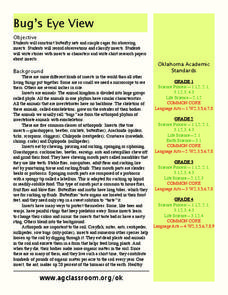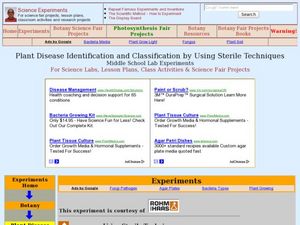Curated OER
Animal: Unique Creatures With Great Features
Learners present models, oral reports, and presentations on animal's characteristics. They research various animals and the characteristics that link them to specific animal groups. They answer specific questions relating to animals in...
Curated OER
Living and Non-Living Things | What’s Alive?
Students compare and contrast living and nonliving things. In this classification lesson, students read a book featuring living and nonliving things and then sort pictures of living and nonliving things.
Curated OER
Who's Who?
Students explore biology by identifying animals and their environments. In this animal characteristic instructional activity, students read assigned text about farm animals, how they are raised, and what they are used for in our society....
Curated OER
PRIMATE CLASSIFICATION: Evolution, Cladograms,
Students transfer examples (names) of primates from their location in an outline hierarchy of primate groups into a set of nested boxes reflecting that same hierarchy. A cladogram can then be drawn illustrating how these groups are...
Curated OER
Animal Species Richness in Tioga County, PA
Learners compile an extensive list of animal species seen throughout Tioga County. In this data collecting lesson, students report daily any animal species seen during the course of their travels and adventures outdoors in Tioga County...
Curated OER
And the Streets Are Paved With Gold
Students explore immigrant experience at Ellis Island, New York, at the turn of the century, and answer questions that challenge them to use thinking skills from various levels of Bloom's taxonomy.
Curated OER
Bug's Eye View
Learners explore biology by writing fictitious stories in class. In this insect life lesson, students identify many different types of insects in the animal kingdom and the classifications they fall into. Learners collect insects on a...
Curated OER
Invertebrate Classification
Students discuss the recent disovery of the "furry lobster" to peak interest in the animal kingdom. They classify various speciments using invertebrate dichotomous keys, identifying major animal phyla and classes. Thy the complete the...
Curated OER
Naming New Species
Students explore science of taxonomy and the Five Kingdoms of life,
categorize organisms into Kingdoms, and create multi-media presentations illustrating knowledge of a Kingdom. They collect data and related pictures on the Internet,...
Curated OER
Kids for Conservation: Animal Unit
Students discuss animal needs and characteristics. In this animal mini-unit, students complete three activities studying different animals, their needs, how they have evolved, and how to protect them.
Curated OER
Invertebrate Chordates
Most chordates are easy to identify because of the specific classification criteria of their phylum. But what about tunicates? Young scientists read a short explanation about why tunicates, or sea squirts, are considered to be members of...
Curated OER
Classifying Organisms within Kingdoms
High schoolers examine animal kingdom classifications. They discuss how animals are placed into kingdom classifications and compare similarities and differences of animals within a kingdom.
Curated OER
Jay Play
Students explore animal characteristics by participating in a bird observation activity. In this blue jay identification instructional activity, students discuss the different types of blue jays native to their environment and bait them...
K5 Learning
Will the Wolf
How well can a wolf survive without a pack? Third graders read about headstrong Will and his desire to be an independent wolf with a short story and series of comprehension questions.
Scholastic
Minibeasts
Lead young scientists to discover insects outdoors. After investigating, students will record observations, learn about these fascinating creatures, craft, and role play.
Curated OER
Plant Disease Identification and Classification by Using Sterile Techniques
Seventh graders identify how to use sterile techniques when identifying plant pathogens. In this plant diseases lesson students complete a lab activity in which they see how plant diseases are identified and classified.
Curated OER
Classification of an Invertebrate: Sponge
Students investigate the invertebrate sponge. In this invertebrates lesson plan, students observe the sponge, Grantia, using a dissecting microscope. Students answer questions about their observations and view six other invertebrates....
Curated OER
OBSERVING THE ROLES OF MALES AND FEMALES IN THE NURTURING OF THE YOUNG THROUGHOUT THE ANIMAL KINGDOM
Students watch animal videos to identify and compare the male/female roles of different species of animals. They draw conclusions and compare those roles to those of humans. They discuss how the human male/female roles have changed...
Curated OER
Learning About Mammals
Students study the mammal classification and forms of them living in the United States. In this mammal study instructional activity, students read through orders of mammals that exist in the United States. Students also study the...
Curated OER
What Animals Need to Live
Fourth graders read "Habitat: What Animals Need to Live" then create a Venn diagram for herbivore, omnivore, and carnivore. In this animal survival lesson, 4th graders determine where different animals need to live depending on what they...
Curated OER
Animals and Humans Say the Darnedest Things
Students explore and analyze human and animal communications and create a short film that illustrates their findings.
Curated OER
So You Think You're Tough
Fourth graders learn how to classify animals. In this invertebrates lesson plan, 4th graders discuss how we classify thinks into groups and move into a discussion about classifying animals. Students learn about the differences between...
Curated OER
Introductory Bacteria and Virus Worksheet
Compare and contrast eukaryotes, prokaryotes, and viruses with a chart and a Venn diagram. Beginning microbiologists consider motility, reproductive ability, DNA content, and the presence of organelles. They write short answers to...
ARKive
Temperate Rainforest in the Pacific Northwest
Explore the amazing temperate rainforest of the Pacific Northwest. Your class starts by investigating the animals and plants of the Northwest, specifically Washington, and then research an animal population common to the area. In small...

























